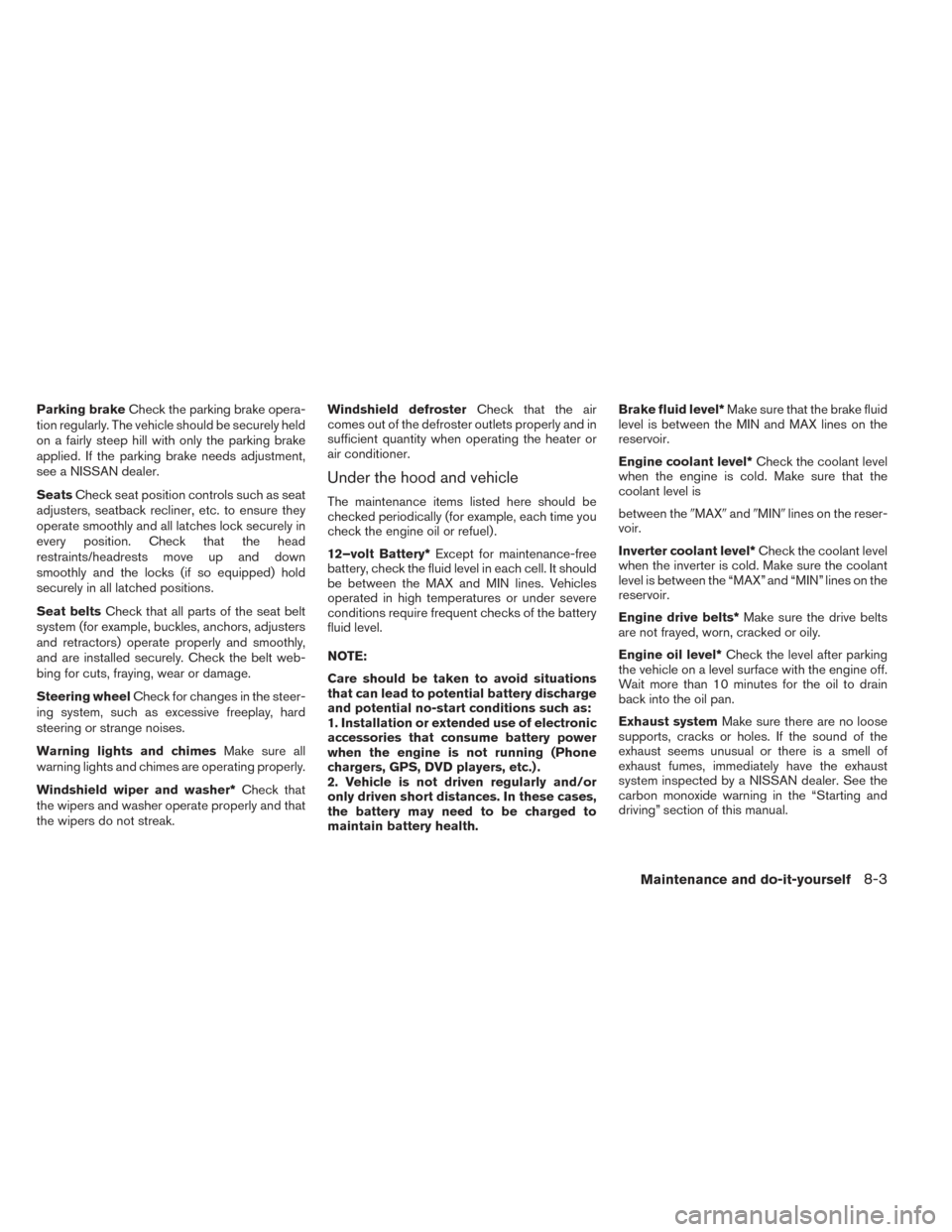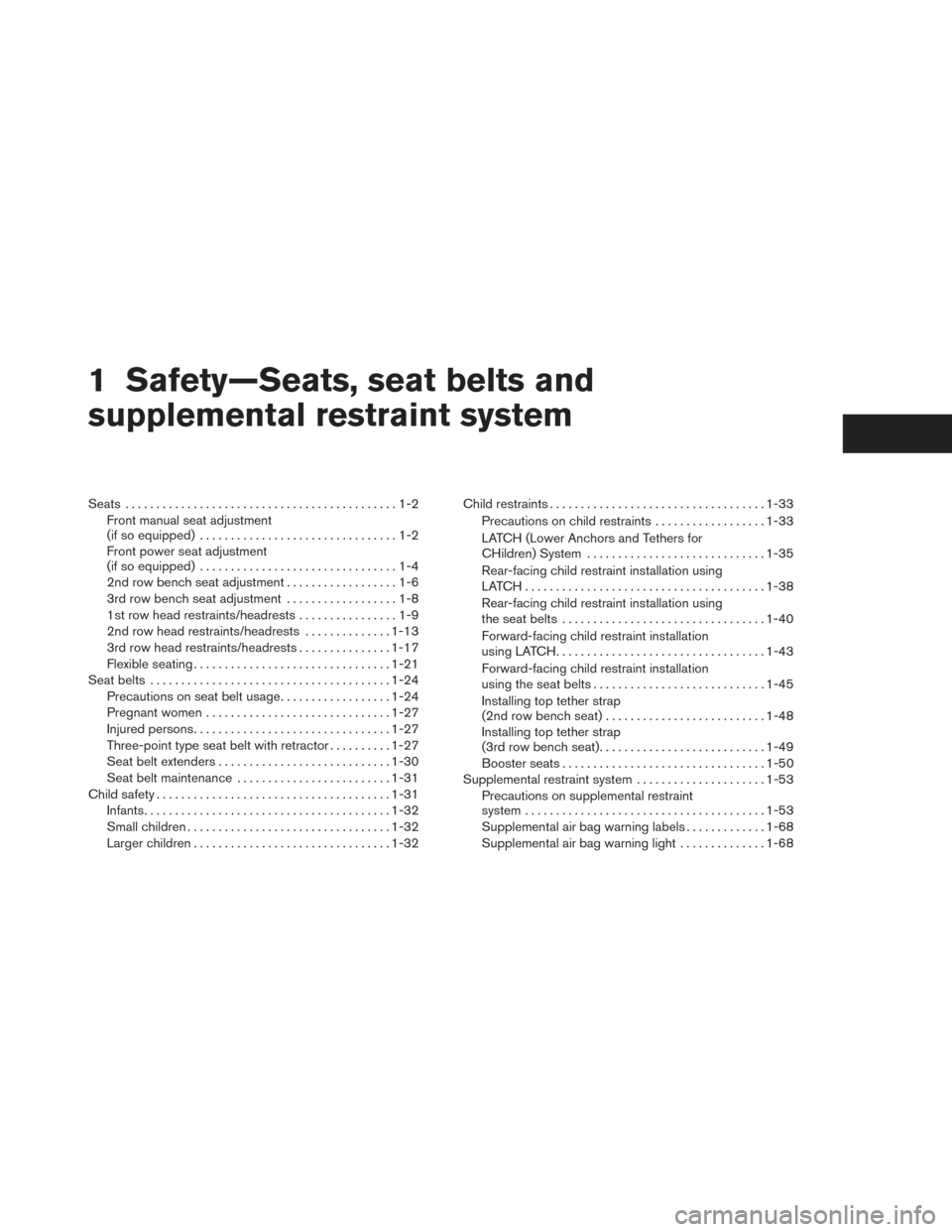Page 6 of 571
Table of
ContentsHEV Overview
Illustrated table of contents
Safety—Seats, seat belts and supplemental restraint system
Instruments and controls
Pre-driving checks and adjustments
Monitor, climate, audio, phone and voice recognition systems
Starting and driving
In case of emergency
Appearance and care
Maintenance and do-it-yourself
Technical and consumer information
Index
HEV0
1
2
3
4
5
6
7
8
9
10
Page 26 of 571
1 Safety—Seats, seat belts and
supplemental restraint system
Front power seat adjustment
(if so equipped)................................1-2
Page 27 of 571
FRONT POWER SEAT ADJUSTMENT
(if so equipped)
Do not operate the power seat switch for a long
period of time when the hybrid system is not
running. This will discharge the 12–volt battery.
See “Automatic drive positioner” in “Pre-driving
checks and adjustments” for automatic drive po-
sitioner operation.
1-2Safety—Seats, seat belts and supplemental restraint system
Page 58 of 571

Parking brakeCheck the parking brake opera-
tion regularly. The vehicle should be securely held
on a fairly steep hill with only the parking brake
applied. If the parking brake needs adjustment,
see a NISSAN dealer.
Seats Check seat position controls such as seat
adjusters, seatback recliner, etc. to ensure they
operate smoothly and all latches lock securely in
every position. Check that the head
restraints/headrests move up and down
smoothly and the locks (if so equipped) hold
securely in all latched positions.
Seat belts Check that all parts of the seat belt
system (for example, buckles, anchors, adjusters
and retractors) operate properly and smoothly,
and are installed securely. Check the belt web-
bing for cuts, fraying, wear or damage.
Steering wheel Check for changes in the steer-
ing system, such as excessive freeplay, hard
steering or strange noises.
Warning lights and chimes Make sure all
warning lights and chimes are operating properly.
Windshield wiper and washer* Check that
the wipers and washer operate properly and that
the wipers do not streak. Windshield defroster
Check that the air
comes out of the defroster outlets properly and in
sufficient quantity when operating the heater or
air conditioner.
Under the hood and vehicle
The maintenance items listed here should be
checked periodically (for example, each time you
check the engine oil or refuel) .
12–volt Battery* Except for maintenance-free
battery, check the fluid level in each cell. It should
be between the MAX and MIN lines. Vehicles
operated in high temperatures or under severe
conditions require frequent checks of the battery
fluid level.
NOTE:
Care should be taken to avoid situations
that can lead to potential battery discharge
and potential no-start conditions such as:
1. Installation or extended use of electronic
accessories that consume battery power
when the engine is not running (Phone
chargers, GPS, DVD players, etc.) .
2. Vehicle is not driven regularly and/or
only driven short distances. In these cases,
the battery may need to be charged to
maintain battery health. Brake fluid level*
Make sure that the brake fluid
level is between the MIN and MAX lines on the
reservoir.
Engine coolant level* Check the coolant level
when the engine is cold. Make sure that the
coolant level is
between the �MAX�and�MIN� lines on the reser-
voir.
Inverter coolant level* Check the coolant level
when the inverter is cold. Make sure the coolant
level is between the “MAX” and “MIN” lines on the
reservoir.
Engine drive belts* Make sure the drive belts
are not frayed, worn, cracked or oily.
Engine oil level* Check the level after parking
the vehicle on a level surface with the engine off.
Wait more than 10 minutes for the oil to drain
back into the oil pan.
Exhaust system Make sure there are no loose
supports, cracks or holes. If the sound of the
exhaust seems unusual or there is a smell of
exhaust fumes, immediately have the exhaust
system inspected by a NISSAN dealer. See the
carbon monoxide warning in the “Starting and
driving” section of this manual.
Maintenance and do-it-yourself8-3
Page 85 of 571
Table of
ContentsIllustrated table of contents
Safety—Seats, seat belts and supplemental restraint system
Instruments and controls
Pre-driving checks and adjustments
Monitor, climate, audio, phone and voice recognition systems
Starting and driving
In case of emergency
Appearance and care
Maintenance and do-it-yourself
Technical and consumer information
Index
0
1
2
3
4
5
6
7
8
9
10
Page 88 of 571
1. Supplemental front-impact air bags(P.1-53)
2. Occupant classification sensor
(weight sensor)
3. Seat belts (P. 1-24)
4. Head restraints/headrests (P.1-9)
5. Roof-mounted curtain side-impact
supplemental air bag (P. 1-53)
6. 3rd row bench seat top tether strap
anchor (located on bottom of seatback)
(P. 1-49 )
7. Folding 3rd row bench (P. 1-8)
8. 2nd row seat top tether strap anchor
(located on bottom of seatback)
(P. 1-48)
9. LATCH (Lower Anchors and Tethers for
CHildren) (P. 1-35)
10. Folding 2nd row bench (P. 1-6)
11. Front seat-mounted side-impact
supplemental air bag (P. 1-53)
12. Seat belt with pretensioner (P. 1-67)
13. Seats (1st row) (P. 1-2)
See the page number indicated in paren-
theses for operating details.
LII2081
AIR BAGS, SEAT BELTS AND CHILD
RESTRAINTS
0-2Illustrated table of contents
Page 91 of 571
1. Glove box, Console box (P. 2-47)
2. Map lights (P. 2-57)
3. Storage (P. 2-43)
4. Moonroof (if so equipped)/Panoramicsunshade (if so equipped)
(P. 2-52, 2-54)
5. Luggage hooks (P. 2-49)
6. Cup holders (P. 2-45)
7. Seats (P. 1-2, 1-6, 1-8)
8. Sun visors (P. 3-31)
See the page number indicated in paren-
theses for operating details.
LII2047
PASSENGER COMPARTMENT
Illustrated table of contents0-5
Page 97 of 571

1 Safety—Seats, seat belts and
supplemental restraint system
Seats ............................................1-2
Front manual seat adjustment
(if so equipped) ................................1-2
Front power seat adjustment
(if so equipped) ................................1-4
2nd row bench seat adjustment ..................1-6
3rd row bench seat adjustment ..................1-8
1st row head restraints/headrests ................1-9
2nd row head restraints/headrests ..............1-13
3rd row head restraints/headrests ...............1-17
Flexible seating ................................ 1-21
Seat belts ....................................... 1-24
Precautions on seat belt usage ..................1-24
Pregnant women .............................. 1-27
Injured persons ................................ 1-27
Three-point type seat belt with retractor ..........1-27
Seat belt extenders ............................ 1-30
Seat belt maintenance ......................... 1-31
Child safety ...................................... 1-31
Infants ........................................ 1-32
Small children ................................. 1-32
Larger children ................................ 1-32Child restraints
................................... 1-33
Precautions on child restraints ..................1-33
LATCH (Lower Anchors and Tethers for
CHildren) System ............................. 1-35
Rear-facing child restraint installation using
LATCH....................................... 1-38
Rear-facing child restraint installation using
the seat belts . . ............................... 1-40
Forward-facing child restraint installation
using LATCH. . . ............................... 1-43
Forward-facing child restraint installation
using the seat belts ............................ 1-45
Installing top tether strap
(2nd row bench seat) .......................... 1-48
Installing top tether strap
(3rd row bench seat) ........................... 1-49
Booster seats ................................. 1-50
Supplemental restraint system .....................1-53
Precautions on supplemental restraint
system ....................................... 1-53
Supplemental air bag warning labels .............1-68
Supplemental
air bag warning light ..............1-68